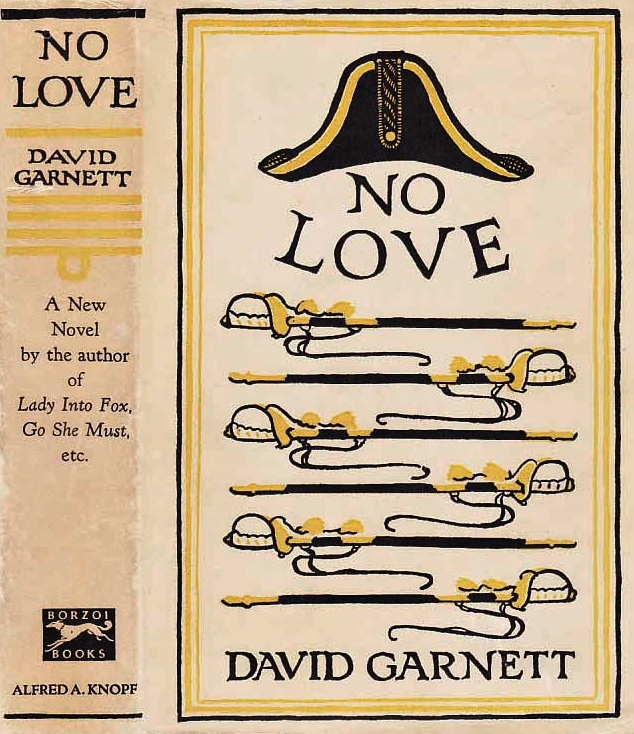
Considering I wrote about David Garnett substantially in my doctorate thesis, it is a bit embarrassing how few of his novels I’ve read. In my defence, I wrote about his first books (Lady Into Fox and The Man in the Zoo), so his later books were less relevant – but I must have bought No Love more than ten years ago and had it waiting on my shelves. (The picture above is borrowed from Barb’s review.)
Garnett was particularly prolific in the 1920s, after his bestselling 1922 debut, and he’d already written another six or seven books by the time No Love came out in 1929. It helps that all his early books are so short. This one starts with an arresting line…
When in 1885 Roger Lydiate, the second son of the Bishop of Warrington, and himself a young curate, became engaged to Miss Cross, the marriage was looked on with almost universal disapprobation.
Roger and Alice are on honeymoon in the south of England when they head out by boat to Tinder Island – a location that I think is made up, though it might be a real place with a new name.
“Let us land here,” said Alice, and she was not disappointed when they found themselves wandering through an immense orchard of flowering plum trees. The petals were falling, and when the young people passed out of the first orchard into the one beyond it, they would have seemed to our eyes like a newly wedded couple standing on the church steps, though the thought did not come to them, since confetti was not used in England in the eighties.
It doesn’t take long for them to decide to live there, and Garnett writes (at this stage of No Love) with a sort of fairy tale tone that makes spontaneous, life-changing decisions feel par for the course. The practicalities of being the only inhabitants of an island are dealt with, but rather swiftly. A little work on the land and they are good to go in Tinder Hall – the island’s only, ancient house. They have a daughter, Mabel, and five years later a son called Benedict.
But before long they need more money – and so they sell a section to Captain Keltie, who is much wealthier, after he and his wife fall in love with the island after a serendipitous visit. They build an enormous faux-Elizabethan house.
From the first its size had alarmed the Lydiates; it was its size indeed which had led Roger to fear that it might ultimately be meant to serve as a training college for Dr Barnado’s boys. The house was far larger than seemed reasonable for a family of three. On the ground floor there were hall, dining-room, drawing-room, morning-room, library, billiard-room, conservatory, kitchen and offices; whilst upstairs two bathrooms, a nursery, and twelve bedrooms seemed to show that the Kelties intended to entertain largely.
At first, the Captain Keltie, his wife and their son Simon show no signs of moving into the completed home – but, once they do, the dynamics of the island shift forever. And the lives of the two families are equally changed. No Love follows what happens over the next few decades – on the island, and away.
Garnett often writes about love and tempestuous love affairs, and there are a fair few in this novel despite its title, but I think he is much more interesting on other topics. The friendship between Simon and Benedict is a case in point – we see how two young boys fall into adventures and risks together, but how the disparity in their wealth and their temperaments changes the friendship over the years. Their living arrangements mean they have something of the closeness of family but without its permanence. It’s a relationship that seems to linger even as the two get older and have no especial wish for it to continue – they can’t quite escape this quasi-brotherhood.
As mentioned, I am less interested when Garnett writes about romantic love – but some of his insights into the way characters love were certainly well done. For example…
He distrusted any happiness which came as easily as her love, suspecting it to be a snare to entrap him. All through life he had fought, and his enthusiasms had been met with mockery and he had learnt that the value of anything was proportional to the opposition it provoked; and instinctively he believed that since this was unopposed it could not be love.
I enjoyed reading No Love – Garnett has a natural lightness and gentle dryness to his prose that works best, in my opinion, when he is using it to approach slightly eccentric or unusual characters and situations. Particularly in the first half of No Love, there is plenty of opportunity for this. It works less well when he is trying to be searing or a little sordid. But, being 1929, nothing is too close to the bone – and I found a lot to enjoy here. It’s no Lady Into Fox, but that was a tour de force that would have been impossible and needless to replicate.

